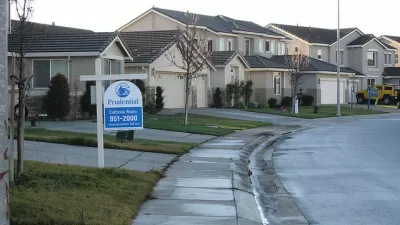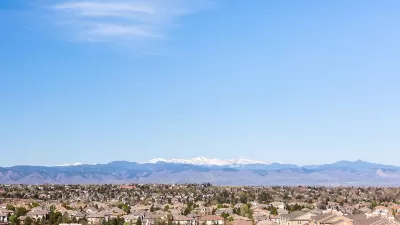Bidding wars, TikToks, and disparate impacts—every day there's more evidence that the pandemic has only worsened the nation's housing affordability crisis.

"It’s a cutthroat competition for a scarce resource, pitting neighbor against neighbor and reinforcing the inequalities the pandemic has so cruelly exposed," Henry Grabar writes about the housing market.
Over a year after stay-at-home and social distancing orders completely overturned the U.S. real estate market, the consequences for the housing market are starting to look a lot like the housing market before the pandemic—increasingly out of reach. Grabar explains:
The promise of the pandemic’s remote-work revolution—a geographic reshuffling that might revive struggling regions and free knowledge workers from high-cost cities—has not yet panned out. Instead, everyone is going exactly where they went before. Far from changing the geography of demand, COVID-19 has given us a housing market that is basically the same, but worse.
Grabar focuses on the scarcity in the market, and the incentives for existing homeowners and the politicians representing them, to prolong the scarcity.
Meanwhile, the experience of looking for a home as the pandemic stretches into its second year grows ever more brutal, as expressed in this satirical video that achieved a large measure of Internet fame last week.
@johnsonfiles Anybody else in this crazy fight for a home?? #realestate #housingmarket #comedy #funny #realestatetiktok #realestatehacks #houseshopping #fixerupper
A Los Angeles Times article by Andrew Khouri takes a traditional news reporting approach to illuminating the bidding wars and price markups that have defined the housing market during the pandemic. Khouri reports the following data as evidence of the unprecedented competition for homes in California:
In March, a home’s median time on the market in the Golden State was eight days, the shortest time period recorded by the California Assn. of Realtors, whose database goes back to 1990. In the bubble years of 2003 to 2005, homes typically took more than 20 days to sell. In the hot-market years preceding the pandemic, the median time on the market at times dipped further, hitting a low of 14 days in 2017.
As the housing market grows more and more out of reach, communities of color are the most impacted by the loss of economic opportunity, according to another article by Mark Zandi for the Philadelphia Inquirer. According to Zandi's coverage, the largest effects of the pandemic and the ongoing scarcity in the housing market is most acutely observable in the lower ends of the market:
Prices for homes sold in the bottom fourth of the market are up nearly 8% per annum over the last decade, almost double that for homes in the top fourth. And rents for those families who rent because they cannot afford to own, rather than by choice, have increased nearly 4% per annum over the last decade — a trend that has continued even during the pandemic.
The result of those trends are reflected also in declining homeownership rates for Latino and Black Americans. "Today, the homeownership rate for Hispanics is 48% and for Blacks it is 42%, a level not seen in decades," writes Zandi.
At least some in the real estate industry are expecting the severe shortage of for-sale homes to loosen in the coming months. A February Zillow study predicted a 17.2 percent increase in for-sale inventory in the residential market in 2021 compared to 2020. Even that increase wouldn't be enough to make up for the decline of inventory in the past year. The same study found a 30.3 percent year-over-year decline in for-sale inventory in February 2021. Hat tip to Kelsey Ramírez for sharing the news of the Zillow study.
FULL STORY: The Good News About the Insane Real Estate Market

Planetizen Federal Action Tracker
A weekly monitor of how Trump’s orders and actions are impacting planners and planning in America.

Map: Where Senate Republicans Want to Sell Your Public Lands
For public land advocates, the Senate Republicans’ proposal to sell millions of acres of public land in the West is “the biggest fight of their careers.”

Restaurant Patios Were a Pandemic Win — Why Were They so Hard to Keep?
Social distancing requirements and changes in travel patterns prompted cities to pilot new uses for street and sidewalk space. Then it got complicated.

Maui's Vacation Rental Debate Turns Ugly
Verbal attacks, misinformation campaigns and fistfights plague a high-stakes debate to convert thousands of vacation rentals into long-term housing.

San Francisco Suspends Traffic Calming Amidst Record Deaths
Citing “a challenging fiscal landscape,” the city will cease the program on the heels of 42 traffic deaths, including 24 pedestrians.

California Homeless Arrests, Citations Spike After Ruling
An investigation reveals that anti-homeless actions increased up to 500% after Grants Pass v. Johnson — even in cities claiming no policy change.
Urban Design for Planners 1: Software Tools
This six-course series explores essential urban design concepts using open source software and equips planners with the tools they need to participate fully in the urban design process.
Planning for Universal Design
Learn the tools for implementing Universal Design in planning regulations.
Heyer Gruel & Associates PA
JM Goldson LLC
Custer County Colorado
City of Camden Redevelopment Agency
City of Astoria
Transportation Research & Education Center (TREC) at Portland State University
Camden Redevelopment Agency
City of Claremont
Municipality of Princeton (NJ)





























